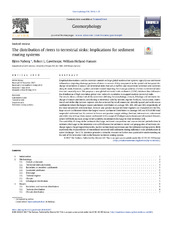| dc.description.abstract | Empirical observations used to constrain controls on large global modern river systems typically use catchment delineations depicting drainage patterns of rivers to oceans. A key component in the spatial and temporal discharge of sediment to oceans are terrestrial sinks that act as buffers and sequestrate sediment and nutrients along its route, however, a global catchment model depicting the drainage patterns of rivers to terrestrial sinks does not currently exist. We propose a new global terrestrial sink catchment (GTSC) database that delineates the distribution of high-resolution global river networks in relation to mapped modern terrestrial sinks. The results show a distinct set of characteristics defining the morphology, climate, lithology and sediment discharge of source catchments contributing to terrestrial sinks by tectonic regime. Foreland, intracratonic, extensional and strike-slip tectonic regimes are characterized by small, numerous, densely spaced and wide source catchments where the largest source catchment contributes on average 50%, 43%, 36% and 36%, respectively, of the total suspended sediment load. Forearc and passive margin tectonic regimes are characterized by few, large source catchments where the largest source catchment contributes on average 64% and 63% of the total suspended sediment load. In contrast to forearc and passive margin settings, foreland, intracratonic, extensional and strike-slip settings show source catchments with a range of lithologies and a dominance of seasonal climates, which will likely increase along-strike variability in sediment discharge to their terrestrial sink. The variability of along-strike sediment discharge, sediment composition and source-derived perturbations in sediment discharge to the terrestrial sink will influence the sediments stored and propagation of sediment discharge signals. On geological timescales, marine sedimentary successions and the sediment routing system, likely represents the characteristics of remobilized terrestrial sink sediments during millennial scale perturbations in water discharge. The GTSC database provides a valuable resource to further our quantitative understanding on the role of the terrestrial sink on the broader sediment routing system. | en_US |

